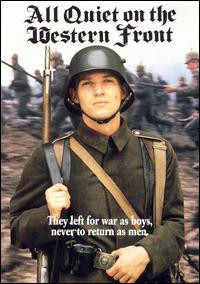VS.
EFFECTS,
SOUNDS, MUSIC: “All Quiet” (1930)
has great effects for a movie released in 1930.
Like most WWI movies, the bombardment effects are impressive. However, the effects director tends to have
his bombardments appear as a perfect line of explosions. No artillery barrage could have been that
accurate. There is certainly a lot of
earth thrown around. The sound effects
tend toward noisy over quality. Most of
the shells whine. There are some really
cool staccato machine gun sounds. As far
as music, there is no soundtrack. I
believe it is better to have too little music than too much, but a little would
have enhanced the film. GRADE
- B-
“All Quiet” (1979) is a made-for-TV movie so you can’t
expect spectacular effects. The
bombardment effects are fine. The sounds
are excellent. When the men go through
the barbed wire, you hear the tinkling.
Surprisingly for a modern war movie, there is not much of a soundtrack. Alyn Ferguson was a well-respected composer
for mostly TV productions. He was not
looking to win an Emmy for his work here.
The soundtrack does not tug at emotions or tell you how to feel. Most scenes have no music. GRADE - C
FIRST
QUARTER SCORE: 1930 -
7 1979 - 6
INTERIORS
AND EXTERIORS: “All Quiet” (1930) is
weak on interiors. The dugouts are too
simple. There are no bunk beds
evident. This is not accurate for
depicting the elaborate underground structures the Germans constructed. The billets are fine, but lack much mise en
scene. The military hospital is too pristine and quiet. No one is screaming in pain. There was no chaos. No man’s land is excellently recreated. There are plenty of shell craters and barbed
wire. The trenches are fairly generic
and there is little evidence of the zig-zag nature of the real trenches. GRADE - B-
“All Quiet” (1979) has a bunker scene with bunks. It is sturdily built. Several billets are in bombed out buildings. The hospital looks more realistic than in the
1930 version as it is crowded and busy, but still too quiet. The classroom and Paul’s home appear to have
verisimilitude No man’s land is medium scale, but a crane
shot shows it as appropriately pock-marked.
The trench is zig-zag in configuration and a later scene even has a
fire-step. The towns in France show the
effects of bombardment (but that just might be the Czechoslovakian locales the
movie was filmed in). GRADE
- A-
HALFTIME
SCORE: 1930 -
14 1979 - 14
CINEMATOGRAPHY: “All Quiet” (1930) was nominated for Best
Cinematography at the Academy Awards.
Arthur Edeson was one of the great Old School cinematographers. He was fond of shots through doorways and
windows. As you watch the movie, you are
aware of the movie’s composition. It is
one of the reasons the film is considered a masterpiece. Although made in 1930, the big trench battle
is a tour de force with tracking shots and the POV shots of the machine guns
mowing down the fodder. The movie is
most famous for its shots of the French jumping into the trench. GRADE - A
John Coquillon filmed the new version. He also did “Cross of Iron” among many other
movies. His efforts are workmanlike and
there are few bells or whistles. I did
not drop my jaw a single time. It’s
above average for a made-for-TV movie.
Some of the cinematography makes nods to the original, like the severed
hands on the barbed wire and the hand-to-hand combat. GRADE - C
THIRD
QUARTER SCORE: 1930 -
23 1979 - 20
CHARACTER
DEVELOPMENT: There are ten
significant characters in both movies.
The 1930 version does a great job on three of them: Paul, Kat, and Tjaden. Himmelstoss is one note. We know he is a postman who lets power go to
his head. The squadmates are hard to
distinguish without a scorecard. GRADE
- C
The 1979 version spends more time establishing the
various personalities. In particular,
the new version is much better at Paul’s arc from naïve schoolboy to cynical
veteran. Almost every scene centering on
Paul is an improvement over the original in developing his character. A subtle
theme is Paul’s eventual smoking of cigarettes. The movie makes a point of
identifying his comrades in an early voiceover.
GRADE - A
FINAL
SCORE: 1930 - 29
1979 - 29
MATCH
ANALYSIS: Wow, another
tie. I think under the circumstances I
am going to advance the original. Using
a boxing analogy, if you want to take the crown from the champ, you have to
beat them decisively. I do not feel the
categories were the right ones for determining which is the better movie, but I
have to stick to the format. I am
working on a future post that will determine which movie is the better version
of the novel.
_poster.jpg)

Which would you recommend for a classroom of 10th graders? I am leaning toward the original, but I also know that modern day students don't appreciate black and white. The additional character development might be better for them too. What are your thoughts?
ReplyDeleteNo doubt the new one is much better for high schoolers. I have shown both and had much more success with the remake. It's not just the black and white, it's also the acting that turns students off when you show the original.
Delete